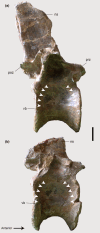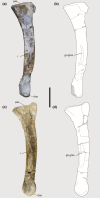Reconstruction of the pelvic girdle and hindlimb musculature of the early tetanurans Piatnitzkysauridae (Theropoda, Megalosauroidea)
- PMID: 38037880
- PMCID: PMC10941590
- DOI: 10.1111/joa.13983
Reconstruction of the pelvic girdle and hindlimb musculature of the early tetanurans Piatnitzkysauridae (Theropoda, Megalosauroidea)
Abstract
Piatnitzkysauridae were Jurassic theropods that represented the earliest diverging branch of Megalosauroidea, being one of the earliest lineages to have evolved moderate body size. This clade's typical body size and some unusual anatomical features raise questions about locomotor function and specializations to aid in body support; and other palaeobiological issues. Biomechanical models and simulations can illuminate how extinct animals may have moved, but require anatomical data as inputs. With a phylogenetic context, osteological evidence, and neontological data on anatomy, it is possible to infer the musculature of extinct taxa. Here, we reconstructed the hindlimb musculature of Piatnitzkysauridae (Condorraptor, Marshosaurus, and Piatnitzkysaurus). We chose this clade for future usage in biomechanics, for comparisons with myological reconstructions of other theropods, and for the resulting evolutionary implications of our reconstructions; differential preservation affects these inferences, so we discuss these issues as well. We considered 32 muscles in total: for Piatnitzkysaurus, the attachments of 29 muscles could be inferred based on the osteological correlates; meanwhile, in Condorraptor and Marshosaurus, we respectively inferred 21 and 12 muscles. We found great anatomical similarity within Piatnitzkysauridae, but differences such as the origin of M. ambiens and size of M. caudofemoralis brevis are present. Similarities were evident with Aves, such as the division of the M. iliofemoralis externus and M. iliotrochantericus caudalis and a broad depression for the M. gastrocnemius pars medialis origin on the cnemial crest. Nevertheless, we infer plesiomorphic features such as the origins of M. puboischiofemoralis internus 1 around the "cuppedicus" fossa and M. ischiotrochantericus medially on the ischium. As the first attempt to reconstruct muscles in early tetanurans, our study allows a more complete understanding of myological evolution in theropod pelvic appendages.
Keywords: Dinosauria; Jurassic; extant phylogenetic bracket; functional morphology; soft-tissue.
© 2023 The Authors. Journal of Anatomy published by John Wiley & Sons Ltd on behalf of Anatomical Society.
Figures


















References
-
- Bates, K.T. , Benson, R.B.J. & Falkingham, P.L. (2012) A computational analysis of locomotor anatomy and body mass evolution in Allosauroidea (Dinosauria, Theropoda). Paleobiology, 38(3), 486–507.
Publication types
MeSH terms
Grants and funding
LinkOut - more resources
Full Text Sources
Research Materials
Miscellaneous

